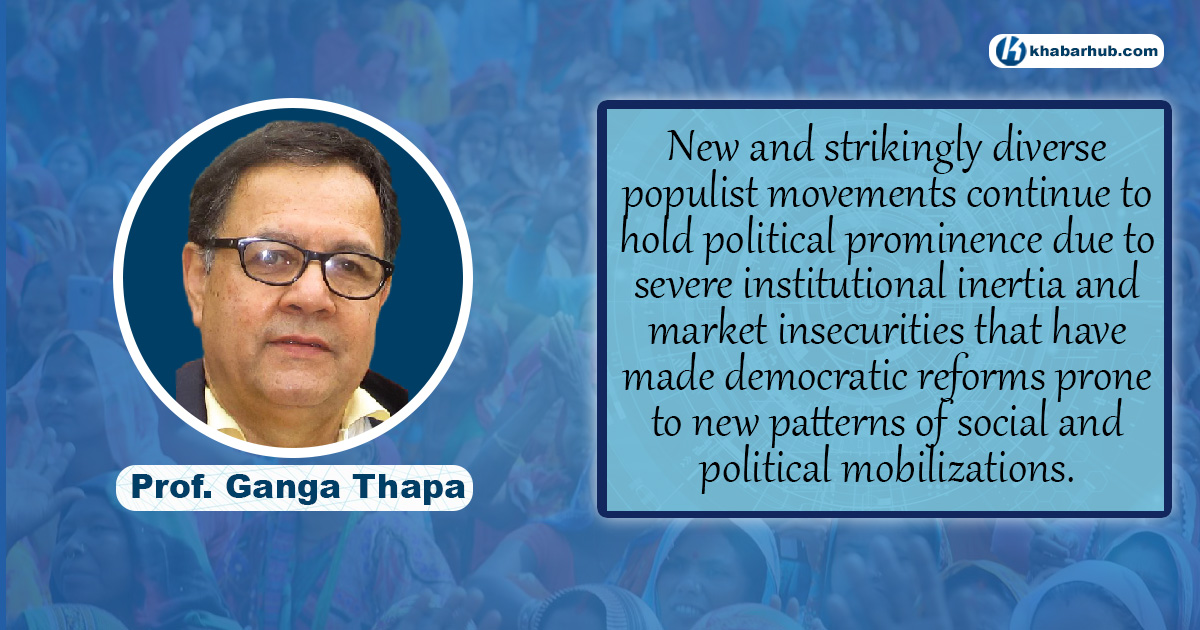0%
Today, the basic points of political debate revolve around the question whether shared norms and beliefs can determine a public policy.

We may all agree that with the demise of state-sponsored tyrannies liberal democracy has emerged as the final form of government, akin to what Fukuyama declared the ‘end of history’ three decades ago. That was a period of a big shift since European nations were first shuffled into a sovereign order by the Treaty of Westphalia in 1648.
One of the striking features of this great political quake has also been the emergence of general discourse on good government and democratization or transition to democracy. New and strikingly diverse populist movements continue to hold political prominence due to severe institutional inertia and market insecurities that have made democratic reforms prone to new patterns of social and political mobilizations.
However, its repeated failure to adequately consolidate democratic institutions and overcome problems of discrimination and economic disparity is largely due to weird manipulations of political mafia from among limping proletarians of orthodox Marxism-Leninism-Maoism through pompous democrats.
Today, the basic points of political debate revolve around the question whether shared norms and beliefs can determine a public policy. The old Platonic view that a citizen might be unable to comprehend the complexities of government to understand the crude realities and so, politics must be secured from the impact of public opinion now seems as implausible as Almond and Powell’s made on civic culture that remained fixated on and dominated by power elites for decades and now face serious challenge.
Much of what we know about Nepal is that since 1948 it has faced three waves of democracy and seven constitutions. However, its repeated failure to adequately consolidate democratic institutions and overcome problems of discrimination and economic disparity is largely due to weird manipulations of political mafia from among limping proletarians of orthodox Marxism-Leninism-Maoism through pompous democrats. Many people now realize that the old problems of perennial order such as dominant state and fragmented society remain largely in place. This induces one to visualize two kinds of threat: return of authoritarianism or roller-coaster form of conflict. Nepal’s current phenomenon is also linked to its geostrategic position and Omni directional foreign policy which is incompatible for peace, prosperity and stability.
Whether Nepalese transition fits well in the standard parameters of democratization literature is an open-ended puzzle.
Nepal’s political matrix for structural changes is evident, especially in terms of the manoeuvres to solve the fundamental issues to set up democratic pluralism despite manifestation of populism by classic left and right diehards. The question is whether the transitional journey is indeed toward the rule of law, accountability, responsiveness, freedom, and equality.
Even today, it would be no exaggeration to say that division exists in Nepalese society between the powerful elite which constitutes a small minority of the population but has been able to constantly remain dominant in terms of social, political and economic powers.
Politically, the revolution for republic in 2006 ended the combat phase of the Maoists’ conflict, bringing them into the mainstream. Whether Nepalese transition fits well in the standard parameters of democratization literature is an open-ended puzzle. In fact, the impetus for a democratic republic had come primarily from an indigenous groundswell in which the reformers were sufficiently powerful to break down the old order.
It is clear that democracy is a culture of debate. So, theories of deliberative democracy recognize the inclusion of everybody being affected by a decision as the most important criterion for its legitimacy.
Yet, the inability of political parties to manage good governance and internal contradictions, both political and socioeconomic, continued to be virtually monopolized by the few. An irony is that although the republic has dismantled the legal barriers to political participation by women and representation of ethnic or religious minorities, the inner ring, or the nucleus in control of state power and resources of the country, is composed of the same elite group.
Subsequent rings of the society emanate toward the periphery, with the extreme periphery which is farthest from the center consisting of the majority of rural population: predominantly peasants, who severely lack representation and opportunities.
This type of politics has failed to extend the network so that the citizens may share information about their interests, needs and preferences and generate political efficacy that plays a significant role in shaping political participation and civic engagement to duly foster a progressive and participatory democracy.
There is, of course, less agreement over the precise significance of democracy or model of democracy and even concerning people’s political choices and preferences in democracies in terms of finding points of unity in the human condition and perhaps even on fledgling global citizenship. It is clear that democracy is a culture of debate. So, theories of deliberative democracy recognize the inclusion of everybody being affected by a decision as the most important criterion for its legitimacy. That is why democracy has become increasingly prevalent in recent decades.
The central dogma of Nepali politics is largely due to volatile and fragmented party system. Its ‘contentious politics’ is manifested in compliant behavior, dissenting attitude, and deficient leadership skills. This type of politics has failed to extend the network so that the citizens may share information about their interests, needs and preferences and generate political efficacy that plays a significant role in shaping political participation and civic engagement to duly foster a progressive and participatory democracy.
To sum up, we find that good governance is virtually the missing link in Nepal in order to systematically respond to the shifts in public opinion and to mobilize against injustices in the absence of developed civic virtues by a reputed mechanism. Yet, the present phase of democratization is considerably different in comparison to the earlier periods in the sense that now is the first time that the question of fundamentally restructuring Nepali society has actually been raised.